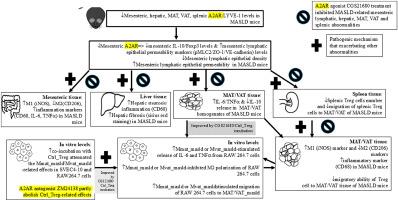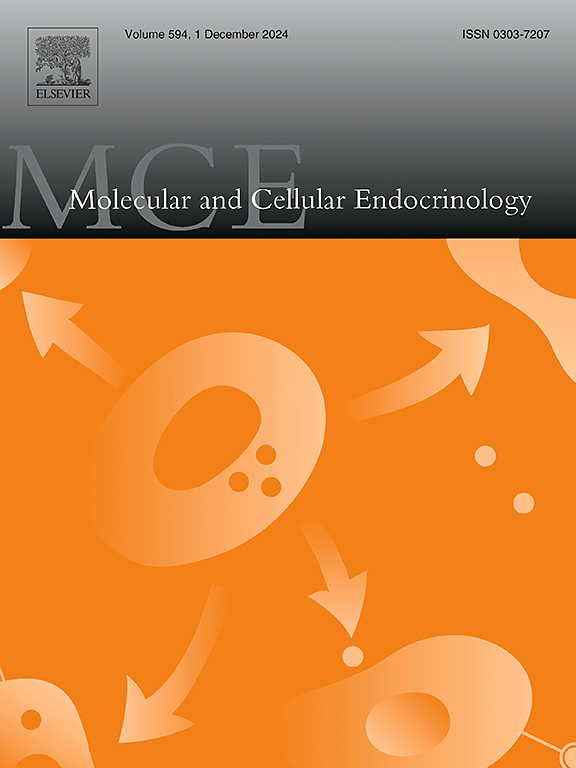Adenosine A2AR agonist blocks mesenteric lymphatic epithelium, adipose tissue and Treg cells links of metabolic dysfunction-associated steatotic liver disease mice
IF 3.6
3区 医学
Q2 CELL BIOLOGY
引用次数: 0
Abstract
Recent studies in diet-induced obese mice indicate crosstalk among mesentery, spleen, serum, and liver metabolites. Observations include decreased expression of the adenosine A2A receptor (A2AR), mesenteric lymphatic hyperpermeability, and reduced Treg cell populations in splenic and adipose tissues in metabolic dysfunction-associated steatotic liver disease (MASLD). This study aims to investigate the mechanisms and effects of a four-week treatment with the A2AR agonist CGS21680 in mice on a high-fat, high-sucrose diet-induced MASLD. In MASLD mice, reduced levels of mesenteric A2AR and the lymphatic epithelial marker LYVE1 (lymphatic vessel endothelial hyaluronan receptor 1) are associated with decreased Treg and M2 phenotype markers, alongside increased permeability markers/permeability of mesenteric lymphatic epithelium. Furthermore, elevated levels of pro-inflammatory cytokines IL-6 and TNFα were observed in serum and tissue homogenates, correlating with reduced splenic Treg cell populations and increased inflammation and fibrosis in mesenteric and hepatic tissues. Chronic treatment with CGS21680 significantly reversed these pathological changes. Additionally, co-incubation of splenic Treg cells with CGS21680 mitigated apoptosis, cellular injury, and leakage in SVEC monolayers, thereby preserving their integrity. This treatment also led to reduced cytokine release and promoted a shift towards an M2 phenotype in RAW 264.7 macrophages. Overall, the A2AR agonist CGS21680 shows promise as a therapeutic agent to inhibit both adipose tissue inflammation and hepatic inflammation/fibrosis by disrupting pathogenic links between adipose tissue, mesenteric lymphatics, and splenic Treg cells in MASLD mice.

腺苷A2AR激动剂阻断代谢功能障碍相关脂肪性肝病小鼠肠系膜淋巴上皮、脂肪组织和Treg细胞通路
最近对饮食诱导肥胖小鼠的研究表明,肠系膜、脾脏、血清和肝脏代谢产物之间存在串扰。观察结果包括腺苷A2A受体(A2AR)表达降低,肠系膜淋巴高通透性,以及代谢功能障碍相关脂肪性肝病(MASLD)中脾脏和脂肪组织Treg细胞群减少。本研究旨在探讨A2AR激动剂CGS21680对小鼠高脂高糖饮食诱导的MASLD的作用机制和影响。在MASLD小鼠中,肠系膜A2AR和淋巴上皮标记物LYVE1(淋巴管内皮透明质酸受体1)水平的降低与Treg和M2表型标记物的降低有关,同时肠系膜淋巴上皮通透性标记物/通透性增加。此外,在血清和组织匀浆中观察到促炎细胞因子IL-6和TNFα水平升高,这与脾脏Treg细胞数量减少以及肠系膜和肝脏组织炎症和纤维化增加有关。慢性用药CGS21680可明显逆转这些病理改变。此外,脾Treg细胞与CGS21680共孵育可减轻SVEC单层细胞的凋亡、细胞损伤和渗漏,从而保持其完整性。这种治疗还导致细胞因子释放减少,并促进RAW 264.7巨噬细胞向M2表型转变。总之,A2AR激动剂CGS21680有望作为一种治疗药物,通过破坏MASLD小鼠脂肪组织、肠系膜淋巴管和脾Treg细胞之间的致病联系,抑制脂肪组织炎症和肝脏炎症/纤维化。
本文章由计算机程序翻译,如有差异,请以英文原文为准。
求助全文
约1分钟内获得全文
求助全文
来源期刊

Molecular and Cellular Endocrinology
医学-内分泌学与代谢
CiteScore
9.00
自引率
2.40%
发文量
174
审稿时长
42 days
期刊介绍:
Molecular and Cellular Endocrinology was established in 1974 to meet the demand for integrated publication on all aspects related to the genetic and biochemical effects, synthesis and secretions of extracellular signals (hormones, neurotransmitters, etc.) and to the understanding of cellular regulatory mechanisms involved in hormonal control.
 求助内容:
求助内容: 应助结果提醒方式:
应助结果提醒方式:


